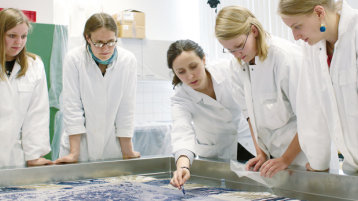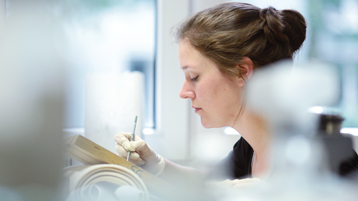Investigation of discolouration in depicted foliage in five 17th century landscape paintings

This Master thesis focussed on technical analysis of depicted foliage in five 17th century landscape paintings in the collection of the Wallraf-Richartz-Museum & Fondation Corboud. Some areas of foliage depicted in these paintings appear to be browned. The aim of the project was to investigate whether this appearance is the result of colour changes and which mechanisms might have caused them.
At a glance
| Kategorie | Beschreibung |
|---|---|
| Student project | Investigation of discolouration in depicted foliage in five 17th century landscape paintings |
| Supervisors | Prof. Dr. Ester Simoes B. Ferreira |
| Student | Charlotte Hoffmann (M.A.) |
| CICS department | Natural Sciences |
| Paintings, Sculptures and Modern Art | |
| Project partners |
Dipl. Rest. Iris Schaefer
Wallraf-Richartz-Museum & Fondation Corboud, Cologne |
| Duration | 09/2017 - 02/2020 |
| Location | CICS / University of Applied Sciences Cologne |
Picture gallery
 0 / 0
0 / 0
Roelant Savery "Animals in a forested mountain landscape", 1629. Detail of the foliage depiction, which appears browned. (Image: TH Köln - CICS - Charlotte Hoffmann)
 0 / 0
0 / 0
Roelant Savery "Animals in a forested mountain landscape", 1629. Microscope images of the dark brown foliage depiction, blue pigment particles are present in the browned binding medium. (Image: TH Köln - CICS - Charlotte Hoffmann)
 0 / 0
0 / 0
Microscope image of a cross-section of a sample taken from the browned glaze in the foliage depiction in the painting by Roelant Savery. The paint layer appears brownish, with blue pigment particles embedded in the browned binding medium. Detail a shows a backscattered electron image, detail b shows the same area in reflected light. Details c to f show the element distribution of copper, calcium, aluminium and lead. (Image: TH Köln - CICS - Charlotte Hoffmann)
 0 / 0
0 / 0
Photographs of paint swatches to illustrate the colour and ageing properties of mixtures of the presumably used pigments in linseed oil. A colour change from green to brown can be clearly seen in the paint containing azurite and a yellow lake in the course of ageing. (Image: TH Köln - CICS - Charlotte Hoffmann)
In her Master project, Charlotte Hoffmann examined foliage depictions in five 17th century landscape paintings within the collection of the Wallraf-Richartz-Museum & Fondation Corboud. Starting point of this art-technological examination was the observation that areas of depicted foliage appeared to be discoloured. The objective was to investigate whether colour changes are present in the areas that appear browned and subsequently to hypothesise on the mechanisms causing this colour change.
The selected landscape paintings were examined microscopically and with analytical methods on micro-samples. Obtained results clearly show that colour changes have occurred in the examined brown areas. The composition of these discoloured paint layers differs from the intact green and intentionally red-brown paint. Mixtures of azurite and a presumably originally yellow lake pigment were used as colourants.
Based on these results, paint outs were prepared and artificially aged to reconstruct possible ageing mechanism. Results support the hypothesis that the browned areas were originally intended to be dark green. The browning is probably mainly due to the high binder content and the associated ageing mechanisms.
Contemporary written sources support the assumption that the examined glazes are discoloured. In the studied text passages, mainly green colours and corresponding pigments or mixtures were described for foliage in landscape paintings. An exception is the depiction of wilted foliage, however, the pigments indicated for this purpose were not detected in the examined paint layers.
In summary, the results of this study contribute to the understanding of the examined landscape paintings in their aged state. The Master project led to a doctoral research project investigating choice of materials, techniques, intended colour effect and colour changes in foliage depictions in 17th century paintings. Since September 2020, Charlotte Hoffmann has been a doctoral student in the interdisciplinary Graduate Research Programme ‘Changing Frames’ at University of Konstanz in cooperation with the State Academy of Fine Arts Stuttgart, funded by the Volkswagen Foundation.
The Master thesis was supervised by Prof. Dr. Ester Ferreira and Dipl.-Rest. Iris Schaefer. Charlotte Hoffmann received a scholarship from the Studienstiftung des deutschen Volkes (German Academic Scholarship Foundation) from March 2019 to June 2020. Main parts of the results of the investigations were published in the Zeitschrift für Kunsttechnologie und Konservierung in 2021.
Article
C. Hoffmann, I. Schaefer, S. Zumbühl, E. Ferreira: Einblicke zu Farbveränderungen in Laubdarstellungen, ZKK 2021 (1), pp. 135-154.



